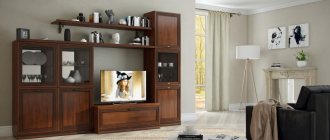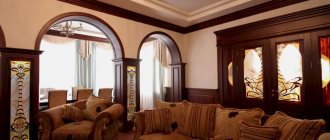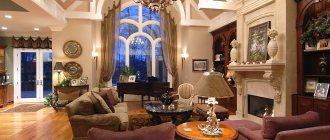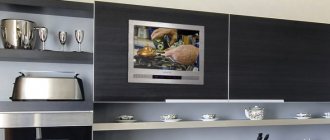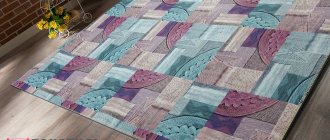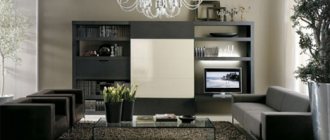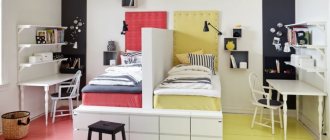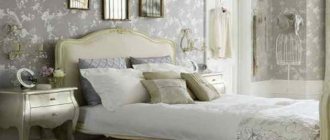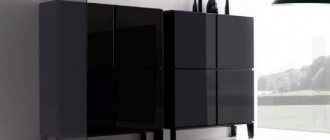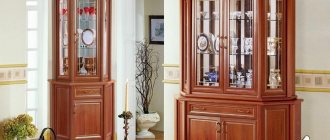Fashion, as we know, goes in circles. Old and seemingly long-forgotten trends sooner or later become trends again. This fully applies to such a movement as Art Deco. The style originated in the first quarter of the twentieth century, quickly became a leader, but by the middle of the century it had lost its relevance. With the advent of the twenty-first century, Art Deco has regained popularity.
Why is Art Deco so attractive today? First of all, a combination of classic luxury and modern technology. By the way, Art Deco is considered the progenitor of the high-tech style - both of these directions are characterized by the use of the latest elements. For example, at the time when Art Deco was born, electric lighting was a novelty, so interiors decorated in this style were literally dotted with light bulbs. The desire for the new makes Art Deco very flexible: it allows, for example, to combine classic furniture and ultra-modern technology with “cosmic” design.
These days, Art Deco is especially in demand for kitchens and bathrooms. This style is characterized by an emphasis on ceramic tiles, countertops, appliances and plumbing fixtures, so it is in these rooms that Art Deco is revealed in all its glory.
Stinginess of the palette
Art Deco is characterized by a craving for achromatic tones - black, white and various shades of gray. Other colors, if present, are in very restrained variations. They are usually muted—smoky or dusty. If we talk specifically about kitchens, then most often they are black and white. This applies to both decoration and furniture.
However, other solutions are possible. Thus, the kitchen set can be made in the color of noble wood or elegant blue. But at the same time, black and white (or gray) will still be present in the decoration, design and details.
Floors (less often walls) are almost always decorated with a combination of black and white tiles. These two colors are combined with a checkerboard pattern, a chevron pattern, or a combination of octagons and square “dots.”
Instead of black and white tiles, gray tiles with a stone pattern can be used.
Art Deco kitchen design
Art Deco wallpaper in the kitchen should be combined with modern furniture and appliances . Since the set will draw attention to itself, the walls can be made lighter and more neutral. For this purpose, plain, textured wallpaper or coatings that imitate antique decorative plaster are suitable.
It is better to decorate the walls in the kitchen in white, beige, gray. This wallpaper will suit furniture of any shape and shade. A combination of light walls and glossy surfaces will provide visual expansion of the limited space of the room.
The atmosphere of solemnity in such kitchens is created by properly selected colors and patterns.
Wallpaper shades can be rich and dark: blue, green, brown, purple, lilac.
As for patterns, experts recommend sticking to small prints. They will not affect the perception of the room, but will become a stylish addition to the design.
The theme of the patterns should correspond to the style of the room: flowers, curls, lines, ancient ornaments and small geometry are suitable.
Symmetry
Clarity, evenness, proportionality - just one way and no other way! There should be no asymmetrical ornateness. There is a central point through which the axis of symmetry passes. The components are located along this axis.
For example, the compositional center of the kitchen can be the stove and the hood above it. This means that cabinets and cabinets should be positioned symmetrically on both sides of this central object. If, of course, the kitchen layout allows such an opportunity.
Parallelism and mirroring are emphasized whenever possible. Specularity refers to the symmetrical arrangement of identical elements, as if reflecting each other.
Finishing, materials
The Art Deco style does not accept cheapness or low quality, therefore it is recommended to select only high-quality materials, such as:
- glass – transparent, frosted, patterned;
- natural wood, mainly valuable species;
- glossy ceramic tiles
- stainless steel;
- natural stone;
- mirrors;
- decorative plasters;
- leather;
- real wild animal fur.
In an art deco interior, only natural materials are acceptable.
Focus on geometry
Art Deco is “obsessed” not only with symmetry, but also with geometricity. Rectangles and circles are clearly not enough for this style. Give him less familiar shapes: trapezoids, rhombuses, hexagons, octagons, triangles, parallelograms, etc. These shapes are present in decoration (tiles), furniture design, decoration.
It's easy to see the pull towards stripes and steps. Stepping appeared in Art Deco as a tribute to the great archaeological discoveries of that time. The designers were inspired by the shape of the ziggurats. In the kitchen, this feature can be manifested in the design of cabinets and cabinets. For example, the central cabinet is located above the rest, and each subsequent pair is positioned lower than the previous one.
Characteristics of an Art Deco kitchen
This style appeared in the 20s of the last century, embodying the desire for luxury and scientific progress. Main features of Art Deco:
- a neat mixture of Eastern and Western styles, antiquity and modernity;
- luxury here is practical, functional;
- geometric patterns are graphic;
- objects have a clearly defined shape;
- Most of the materials used are natural.
Art Deco embodies luxury and comfort.
Chic, sparkle, beauty!
Art Deco interiors can be quite modest or elaborately luxurious. Even if you are planning an almost spartan setting, it is still worth including at least a little “glamour”. Polishing, gloss, mirrors, glass, crystal, metal - all this is included in the list of decorative components of the style.
Art Deco kitchen interior color scheme
Art Deco is characterized by a certain color scheme. Mostly it is white with black or gray; the following combinations also look good:
- beige with black and blue;
- lavender with dark olive;
- brick red with light silver;
- grid-pearl with brown-green;
- pale yellow with emerald bluish;
- basalt gray with snow white;
- copper with mint cream;
- dark purple with almond.
In Art Deco design, only dark colors are unacceptable.
Advice. Such interiors do not need additional accents. It is not allowed to use more than three colors in the space of one room.
Matching Styles
It is wrong to think that Art Deco style curtains are suitable only for the decorative direction of the same name. Since this style is quite eclectic, its elements will harmoniously fit into different room design options.
- Art Deco curtains perfectly complement the atmosphere of an Art Nouveau interior, as these styles are related to each other.
- Such curtains are also suitable for a classic style, especially if the interior is more in line with the spirit of frivolous France rather than restrained England.
- Such textiles look harmonious in ethnic interiors. Curtains decorated with South African or Asian designs will look natural in exotic spaces.
Sewing materials
Not only natural fabrics can be used as curtain material. In addition, they are often less practical than synthetic textiles. However, when choosing fabrics, you should be guided only by personal preferences. To sew curtains in the Art Deco style, use:
- viscose;
- velours;
- velvet;
- jacquard;
- satin;
- silk;
- taffeta;
- atlas;
- organza and other fabrics.
To create curtains, heavy fabrics are often combined with transparent materials. With a well-composed composition, they will combine perfectly and become a real decoration of the windows.
The color range of curtains is practically unlimited. The palette of decorative curtains can be the most extraordinary. The following options have become especially popular:
- The combination of white, black and gold has become a classic. These colors can be combined both on the overall canvas or pattern, and in individual halves of the curtain.
- Orange and blue shades on a chocolate background. Such curtains perfectly complement patterns with white and golden lines.
- In modern interiors, designers use art deco curtains in strawberry and coffee shades, which are complemented by iridescent colors (silver or pearl).
Thus, in terms of color, Art Deco curtains gravitate towards dark, rich shades, which are diluted with richer colors.
Decor, textiles
Photographs arranged in the form of a rhombus, a pyramid, or in steps serve as decoration. Pictures in frames also create a certain composition. Mirrors in the shape of suns and stars beautifully complement the interior. Elegant open shelves also have the most clear configuration; porcelain figurines in the form of animals, people, entire sculptural groups, and massive candlesticks are placed on them. Large amphorae vases decorated with geometric prints are placed on the floor.
Mirror as decor in art deco style.
The textiles here are very diverse: for windows, translucent tulle is suitable, combined with straight curtains, decorated with patterns in the form of diamonds, meanders, plant or animal patterns. Zebra, tiger, and leopard prints are acceptable for armchairs and sofas - they are used to decorate upholstery, blankets, and pillows. The carpet, which usually marks the dining area, is made in a zebra pattern or plain. Leather and fur chair covers are also acceptable.
Advice. Significant decorative elements are additionally illuminated by spotlights and sconces stylized as candelabra.
Kitchen design in art deco style in dark colors.
